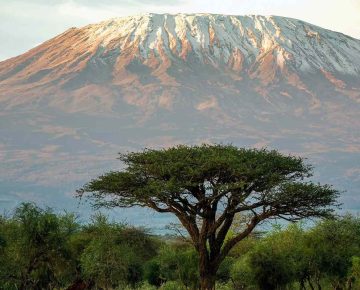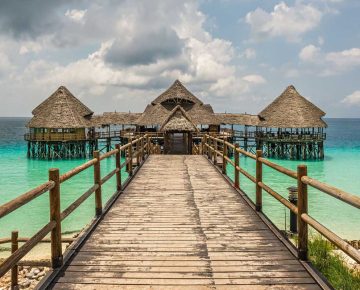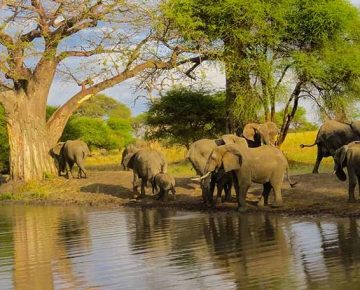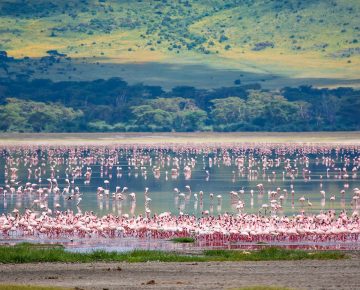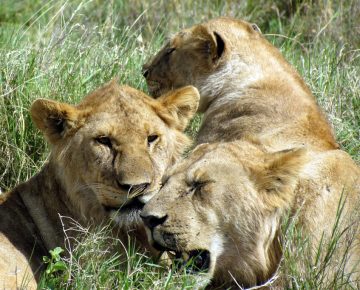Ngorongoro Conservation Area – The World’s largest crater
Ngorongoro Conservation Area is located in Tanzania and is a UNESCO World Heritage site, designated in 1979. It was established in 1959 and is part of the Serengeti National Park in the southern sector. The park is located in the highland craters of Tanzania, and the name originates from the crater within the park called the Ngorongoro Crater. The Ngorongoro Crater is among the seven wonders of the world. The area was established for a purpose, where it was to be used by the Masai semi-nomads who always moved from place to place in search of water and pastures for their animals. The Ngorongoro conservation area is a large and protected with large wildlife populations, breathtaking landscapes, the world’s largest caldera, and many others.
Attractions in the Ngorongoro
There are several attractions in the Ngorongoro conservation area, and these attractions include;
Ngorongoro Crater
This is a significant attraction in the Ngorongoro, which covers 264 kilometers. During a visit to this crater, tourists can have a side view and see animals at dawn. The crater also has lakes with soda water that attract water birds like flamingos and other birds and their predators.

Wildlife
The park is home to a variety of wildlife since it is vast, with a lot of water and swamps used by other animals for cooling. The conservation area is home to some Big Five animals, such as elephants, black rhinos, buffalo, and lions. Wildlife animals include wildebeest, antelopes, warthogs, jackals, and many others.
Bird species
The conservation area is considered a birding paradise because it is home to permanent and migratory birds. The migratory birds come from Europe and parts of Asia, where they usually migrate to Tanzania to breed in the rainy season in September and April.
Lake Magadi
This is a shallow lake with water containing sodium carbonate, and it is home to flamingos. The lake usually crystallizes during the dry season, leaving a thick crystalline layer used as a lick for animals like jackals, hyenas, elephants, and others to supplement their diets. These birds include European swallows, rollers, Caspian lapwings, Montagu’s harriers, and many others.
Olduvai Gorge Museum
This small museum is located in the Olduvai Gorge within the conservation area. Dr. Leaky considers it an archaeological site where he discovered the remains of early man in 1959. The place offers the best views of the animals within the park during a visit to both Ngorongoro and Serengeti National Park.
Activities that one can do in the Ngorongoro Conservation Area
The conservation area has a variety of attractions and activities that attract large numbers of tourists each year, and these activities include;
Game drive and game viewing
A game drive and game viewing in the conservation area provide a great view of the park while in the tour vans. Game drives usually start in the morning and the other in the afternoon. These offer a great view of the park. They involve driving into the crater. You will at least see some of the big five animals during each game drive.
Crater walks
During this walk, the tourists will walk along the edges of the crater while having great views of the vegetation, such as woodlands, open grass, and Acacia, as well as the view of the Masai community outside the park.
Cultural encounters
During your safari to Tanzania, the cultural encounters within the Ngorongoro Conservation Area are among the bucket list activities. You will encounter the
and the last bushmen of Africa through understanding their way of living, feeding, and economic activities.
Hot air balloon safaris
This is one of the highly recommended activities in the Ngorongoro Conservation Area. During this hot air balloon safari, a tourist will enjoy the crater’s great aerial view. A picnic bush breakfast is usually organized to mark a remarkable adventure on your hot air balloon safari. It is a perfect opportunity to see the park’s scenic views from the top.
Birding
The conservation area is considered a birder’s haven because it is home to both permanent and migratory birds, which makes it a good place for birding. Birding tours in this area allow travelers to discover the hidden treasure on a Tanzania birding safari.
Accommodation facilities in the Ngorongoro
The accommodation facilities in the conservation area usually range from mid-range, budget, and high-end facilities, and they include;
Lemale Ngorongoro tented camp. This camp is located in the ancient acacia forest on the edge of the Ngorongoro crater. The facility is luxurious. It is near the road to the Lemale crater in the park’s eastern region, which offers quick access to the crater.
Ngorongoro Sopa Lodge: This lodge is located at the highest point on the edge of the Ngorongoro crater. It offers unparalleled views of the caldera, where the tourists can view the sunset with one of the fine cultural setups.
What is the best time to visit the Ngorongoro Conservation Area?
Like any other safari destination in Tanzania, the Ngorongoro Conservation Area is open for tourists at any time of the year. However, most of the park’s safari activities can easily be done during the dry season, spanning June, July, August, September, December, January, and February. Could you talk to a Tanzania travel specialist now to plan your safari?
How to get there?
Either road or air can access this area. By road, it is 185 kilometers from Arusha, and it takes 2 to 4 hours to arrive at the park. You will board a domestic flight from Arusha to Lake Manyara airstrip by air. Usually, there are daily flights from Arusha to Manyara. Additionally, on how to access the Ngorongoro conservation area, the area has several gates from which you can access it. These gates include;
Lodoare Gate: This gate is in the southern part of the conservation area. It is the most popular gate used by tourists since it is the nearest gate to Arusha. It also has quick access to Lake Magadi, which hosts large flocks of flamingos and the hippo pool.
Naabi Hill Gate: This is another commonly used gate for tourists to access the Ngorongoro. It has access to both the Serengeti National Park and the Ngorongoro Conservation Area. While at this gate, you will see an endless view of the plains of the Ngorongoro Conservation Area and Serengeti National Park.
Lemala gate: This is a mini gate in the northern part of the conservation area. It has both the entry and exit points of the conservation area. It is one hour away from the Lodoare gate.
Seneto Gate: This is a mini gate in the western part of the conservation area. It takes an hour to reach Olduvai Gorge from the gate.


